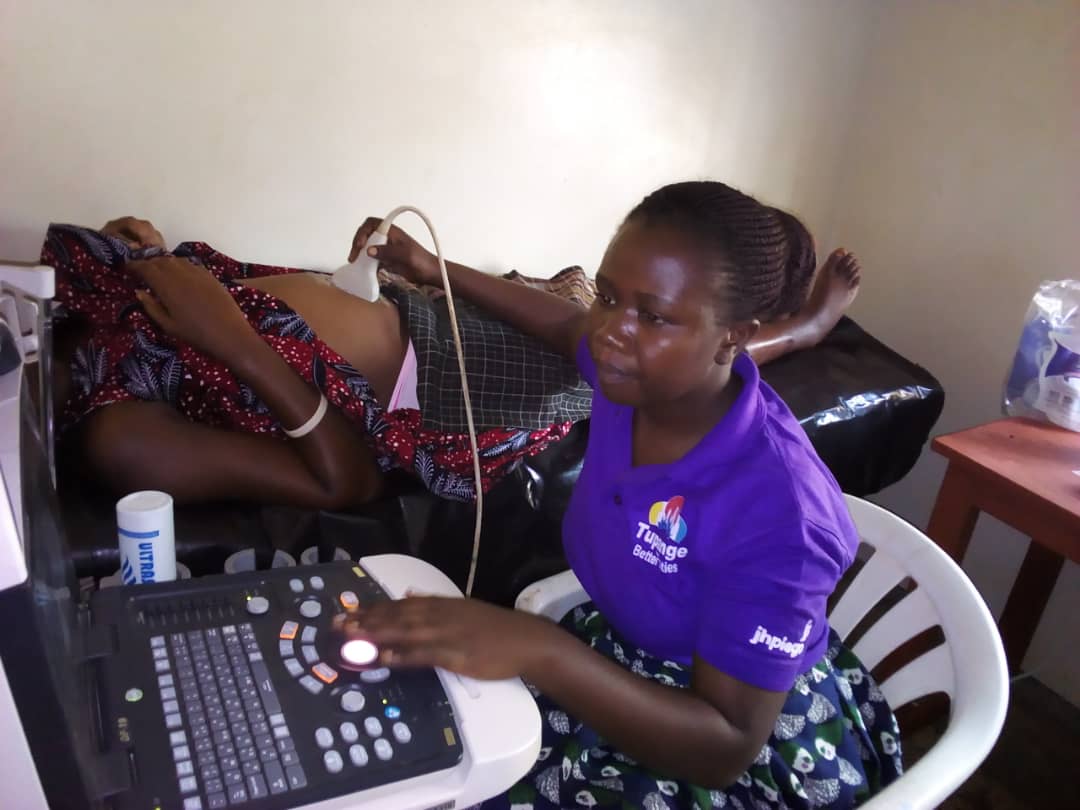
The World Health Organisation (WHO) new antenatal care guidelines recommend that every pregnant woman should make eight hospital/health facility antenatal care visits. In addition, pregnant women should have at least 2 obstetric ultrasound scans done; the first being done in early pregnancy (20-22 weeks) and the second in the third trimester/intrapartum for purposes of identifying any fetal anomalies and complications.
This is also in line with Uganda’s RMNCAH (Reproductive Maternal Newborn Child Adolescent Health) Investment case. In Luuka, most pregnant mothers seek antenatal care from lower level health facilities. The district of Luuka in Eastern Uganda lacks a hospital and the highest level of service provision is at Kiyunga Health Centre IV. Most of these women do not have access to ultrasound scan services as these are non-existent in the district. However, those who must get a scan done have to incur travel expenses to the nearest district hospital (Iganga-about 30kms away) or private providers (outside Luuka) who can offer these services. This is in addition to paying for the services, which makes it expensive and far from reach for the most-at-need population.
After successful implementation of obstetric ultrasound scan services at the district hospital in Iganga with trained midwives at the forefront of conducting the scans, the Centre of Excellence for Maternal and Newborn Health Research at Makerere University School of Public Health at the beginning of this year launched a pilot study ‘Testing a Community-based Ultrasound Scan system during early and late antenatal care to facilitate gestation age dating, referral and preterm care in Luuka District one the low resource districts in eastern Uganda’ in Eastern Uganda. The aim of the pilot is to collect data and information that will inform scale up of the ultrasound services in lower level health facilities in other districts where it’s lacking. The pilot will assess the acceptability and community perceptions towards obstetric ultrasound scan services, feasibility and vital statistics regarding utilisation of the service in lower level health centres.
During the launch, Dr Jude Mulowooza, an Obstetrician/Gynaecologist and technical advisor on the study pointed out that Uganda still has unacceptably high maternal mortality at 336/100,000 live births and neonatal mortality of 27/1000 live births most of which are due to preventable causes. ‘This means that for every 100,000 mothers who give birth to a live baby, 336 mothers die in the process. Each year, we lose about 6000 mothers and 39,000 newborns’ said Dr Mulowooza. Specifically, most pregnant women die from excessive bleeding, sepsis, obstructed labour and hypertension. He went on to explain that in Uganda, about 74% of mothers deliver from health facilities and this provides a window of opportunity for intervention to prevent deaths. At this point, early identification of complications in pregnancy and labour is crucial. Many of the complications can be identified by ultrasound scanning for example identifying the number of foetuses in the womb, checking fetal viability, fetal presentation, site of the placenta, presence of fetal malformations and gestation age dating which is important especially in cases of prematurity.

With funding from the Research and Innovation Fund at Makerere University (RIF@Mak), the Centre (CMNHR) has provided ultrasound scan machines that are pre-charged, portable and easy to use in rural settings to overcome challenges of lack of electricity to run the scans. These scans have been placed at Kiyunga HC IV and Bukoova HC III in Luuka district. The two health centres combined receive over 300 mothers per week for antenatal care creating a high demand for ultrasound scan services. ‘ We have also trained more than 50 Village Health Team members who are volunteers in community to sensitize, mobilize and refer pregnant women in early gestation age (20-24weeks) to go for ultrasound scan at Kiyunga and Bukoova health centres’ explained the study field coordinator. Prior to instituting the scans, the study team conducted health facility assessments to guide the introduction of the service. To ensure sustainability, the study team engaged the district political and technical leadership and other stakeholders for buy in and discussed ways to supervise the work. The district leadership welcomed the new ultrasound scan project saying it is timely especially since two other initiatives, the Score Card and Results Based Financing, are also being introduced in the district. These innovations/projects will be an important game changer for maternal and newborn health indicators in the district. The district Chairperson LC 5, whose sentiments were re-echoed by the Chief Administrative Officer (CAO) welcomed the MaKSPH team and thanked them for the projects that have been implementing in Luuka especially in improving the lives of mothers and newborns, revamping the Kiyunga health centre IV theatre, and generally improving the livelihood of the community. They pledged to continue supporting and providing necessary assistance for the research teams while in Luuka
Project Coordinator mokuga@musph.ac.ug
